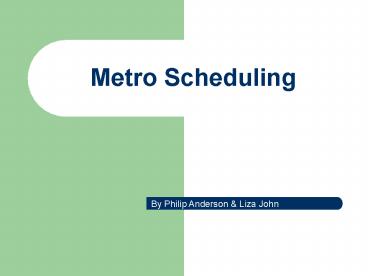Metro Scheduling PowerPoint PPT Presentation
Title: Metro Scheduling
1
Metro Scheduling
By Philip Anderson Liza John
2
Metro Scheduling
- Case Study
- Real world Practice
3
A simple example Model
Station 2
Station 1
Station 3
?3
?2
?1
4
A simple example Arrival Rates
Passenger arrival at each station can be modeled
as a Poisson process having time variable rate ?.
?i
t
5
A simple example Arrival Rates
?
t
6
A simple example Arrival Rates
?i
?is
s
t
7
A simple example Destination Probabilities
Pijs Matrix Probability that a passenger who
entered station i will get off at station j. For
j I P 0.
j
1 2 3
0 P12 1/2 P13 1/2
0 0 P23 1
0 0 0
1 2 3
i
8
A simple example
- Define
- Let r be the time interval between trains.
- From the Central Limit Theorem Nis (the number of
passengers at Mi for period s) is normally
distributed having mean r(?is) an variance r(?is)
. - Objective
- Create a schedule for period s by specifying r to
minimize cost and guarantee capacity constraints
9
A simple example
- Constraints
- Train capacity C
- r 4,,20
- Not reaching capacity 95 percent of the time.
10
A simple example
- Find the smallest r to satisfy all the equations
- 95 gt z 1.65
- Equation 1
- Equation 2
11
A simple example
Results First select the smallest r from solving
equation 1 and 2. If r is gt then 20 assign the
minimum of the two If r is between 4 and 20
assign that value If r is less then 4 then we
cannot guarantee this level of confidence.
12
A simple example Second Look
- Trains are jobs
- Stations are machines
- Flow shop algorithm
- Fm prmu Lmax
- Because the order of the stations, machines,
cannot change, the real problem is figuring out
how many trains, jobs, can be completed with the
given expressed constraints, and still hold true
to the station schedule
12
13
A simple exampleSecond Look
- Rush Hours
- 630AM - 930AM and 330PM - 800PM
- Regular Population Density Hours
- 930AM - 330PM and 800PM - 1200AM
- Late Night Hours
- 12AM - 630AM
14
A simple example Second Look
- Different times in the day allow for different
lengths of wait time - During rush hours people will be waiting around 4
minutes - During regular hours people will be waiting
around 7 minutes - During late night hours people will be waiting
around 20 minutes
15
Simulation
- TOWARD INCREASED USE OF SIMULATION TRANSPORTATION
- Dudley Whitney, Parsons Brinckerhoff Quade
Douglas, Inc. - INVESTIGATING THE CAPACITY OF A METRO LINE BY
MEANS OF A SIMULATION MODEL - A Ballis, K Liberis and T Moschovou
- SIMULATORS USED BY WMATA
- Martin Lukes
16
Simulation TOWARD INCREASED USE OF SIMULATION
TRANSPORTATION
- Construction Feasibility
- Signal Design
- Power Consumption
- Traffic Studies
- Railroad Capacity Studies
- Train Operations Studies
17
Simulation TOWARD INCREASED USE OF SIMULATION
TRANSPORTATION
- Perceived high cost
- Tight budgets
- Tight schedules
How to address these issues?
http//trainlogic.net/sim_wmata.htm

